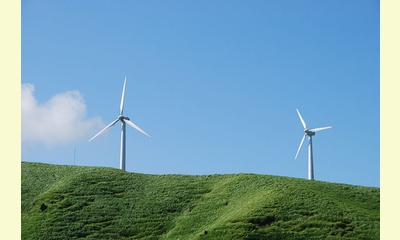|
|
100% Renewable Electricity Will Be Achieved In German State Soon
un articulo por Jake Richardson, Clean Technica
Germany’s windiest area, Schleswig-Holstein, will
probably achieve “100% renewable electricity” sometime this
year. That is, its clean energy production will be able to supply all of
its electricity consumption. Schleswig-Holstein has a goal to
generate 300% of its electricity consumption with renewables
eventually. This mostly rural area is grid-connected, so it can sell
excess electricity and still use conventional power during periods
when wind is not available. 
photo from Wikipedia Commons
click on photo to enlarge
The small state has about 7,000 wind power employees and the
wind turbine manufacturer Vestas has facilities there. A German
Wind Association report pegged the offshore wind power capacity
by 2030 at about 25,000
MW and 4,000-6,000 MW for onshore. Wind power is such a
significant part of the culture that there is a Master’s degree in
Wind Engineering program
available. (The area borders Denmark to the north and is between
the North and Baltic seas.)
Eight years ago, it was reported that the state
generated about 30% of its electricity from wind power, so there has
been much progress.
Getting to 100% renewable electricity is a huge achievement, but it
wouldn’t be a complete first in Germany. One German village
produces over 300% of its electricity from renewables. The village of
Feldheim gets all its
energy from renewable sources as well, mostly wind and biogas.
(Thousands of tourists have visited to see its green technology.)
There are over 190 clean energy sites in Germany, so many that a
green destinations guide for tourists was written and
sold out in its first printing. It will be curious to see if Schleswig-
Holstein begins to attract more green tourists.
|








|
DISCUSSION
Pregunta(s) relacionada(s) al artículo :
How can we get to a sustainable, peaceful economy?,
* * * * *
Comentario más reciente:
Annie Leonard: How to Be More than a Mindful Consumer
The way we make and use stuff is harming the world—and ourselves. To create a system that works, we can't just use our purchasing power. We must turn it into citizen power.
by Annie Leonard
posted Aug 22, 2013
Stuff activist Annie Leonard: “Consumerism, even when it tries to embrace ‘sustainable’ products, is a set of values that teaches us to define ourselves, communicate our identity, and seek meaning through accumulation of stuff, rather than through our values and activities and our community.” YES! photo by Lane Hartwell.
Since I released "The Story of Stuff" six years ago, the most frequent snarky remark I get from people trying to take me down a notch is about my own stuff: Don't you drive a car? What about your computer and your cellphone? What about your books? (To the last one, I answer that the book was printed on paper made from trash, not trees, but that doesn't stop them from smiling smugly at having exposed me as a materialistic hypocrite. Gotcha!)
Let me say it clearly: I'm neither for nor against stuff. I like stuff if it's well-made, honestly marketed, used for a long time, and at the end of its life recycled in a way that doesn't trash the planet, poison people, or exploit workers. Our stuff should not be artifacts of indulgence and disposability, like toys that are forgotten 15 minutes after the wrapping comes off, but things that are both practical and meaningful. British philosopher William Morris said it best: "Have nothing in your house that you do not know to be useful or believe to be beautiful."
Too many T-shirts
The life cycle of a simple cotton T-shirt—worldwide, 4 billion are made, sold, and discarded each year—knits together a chain of seemingly intractable problems, from the elusive definition of sustainable agriculture to the greed and classism of fashion marketing.
The story of a T-shirt not only gives us insight into the complexity of our relationship with even the simplest stuff; it also demonstrates why consumer activism—boycotting or avoiding products that don’t meet our personal standards for sustainability and fairness—will never be enough to bring about real and lasting change. Like a vast Venn diagram covering the entire planet, the environmental and social impacts of cheap T-shirts overlap and intersect on many layers, making it impossible to fix one without addressing the others.
I confess that my T-shirt drawer is so full it's hard to close. . ... continuación.

|
|









